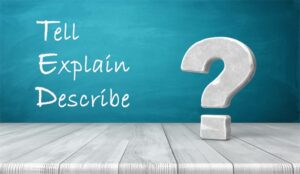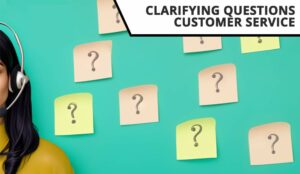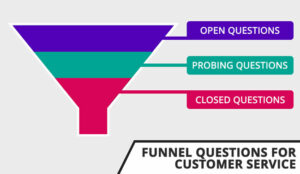Are you just getting started with creating a call script, or looking to take your team back to basics? We’ve got just what you’re looking for!
Our Editor, Megan Jones, spoke to our panel of experts, including Kim Ellis, Jacqui Turner, Jim Oldroyd, and Danny Wareham, as well as some of our readers, to capture the top customer service questions that underpin every positive call – with some helpful hints and tips on where timings and nuances may also apply.
10 Customer Service Questions
In this article we will explore and explain the following ten questions for customer service:
- “How May I Help?”
- “Can You Tell… Explain… Describe…?” (The TED Questions)
- “Is My Understanding Correct?”
- “What Would Be the Ideal Outcome for You Today?”
- “Have I Covered Everything?”
- “How Are You Feeling Today?”
- “How Did You Come to That Conclusion?”
- “What Would You Like Me to Call You?”
- “Can You Confirm Your Preferred Pronouns?”
- “How Could We Do More of That for You?”
Core Customer Service Questions
Asking the right questions is so important, as Kim Ellis, Chief Learning Architect at Go Ginger Learning Solutions, explains, “It’s about giving the customer the opportunity to voice their concerns, because the call isn’t about the agent or the company, every call is about the customer and what they need!”
With this in mind, no call script would be complete without the following questions…
1. “How May I Help?”
A good early question in any call is simply “How may I help?”

Oldroyd
This is known as an open question and quickly passes the baton to the customer, as Jim Oldroyd of Bread and Butter Learning Solutions explains:
“This type of question allows the customer to speak, giving them the opportunity to kick-start the conversation by explaining what’s going on.”
This is a far better option than “What do you need?”, as Kim Ellis continues:
“Asking the customer ‘What do you need?’ can come across as quite abrupt, so be conscious of language choice here and opt for the warmer and more inviting alternative of “How may I help?”
2. “Can You Tell… Explain… Describe…?” (The TED Questions)
After asking an open question, such as “how may I help?”, agents should move on to clarifying questions to better understand the customer’s problem. The TED technique can really help here.
TED stands for Tell, Explain, Describe, as seen in the following example questions:
- “Can you TELL me a little bit more about [insert problem]?”
- “Can you EXPLAIN how you first came across [insert problem]?”
- “Can you DESCRIBE the error message you’ve seen?
Using TED questions encourages the customer to give agents as much information as they can to help clarify the problem in hand. This clarification can also help agents avoid assumptions that could cause issues further down the line.
Don’t forget to give customers space to talk too, as Kim Ellis adds, “When using open questions, the agent should always make sure to pause to give the customer enough time to fully answer the question – to avoid interruptions and any frustration.”
3. “Is My Understanding Correct?”
Some customers share so much information that even the best active listeners struggle to absorb every detail, so a good checking question is for the agent to ask, “Is my understanding correct?”

Turner
As Jacqui Turner, Specialist in Customer Service & Team Leader Training at Turner Corner Learning Solutions, explains:
“If an agent misinterprets the customer’s issue, they could easily go off in the wrong direction, causing confusion, as well as adding to their handle time.
“That’s why it’s important to relay back understanding to the customer before going any further.”
For example, the agent could frame the question like this, “My understanding of what’s happened is [insert problem]. Is my understanding correct?”
The agent should then wait for the customer to confirm and follow up accordingly – based on the following scenarios:
- Scenario 1 – The customer says “absolutely”, then the agent knows they can move forward with the conversation and planned resolution.
- Scenario 2 – The customer might say “I did say that, but I didn’t quite mean it in that way”. This opens up the opportunity to talk through what’s been missed before moving forward once more.
- Scenario 3 – The customer says “no”. Again, this opens up the opportunity for further conversation and clarification.
This question is pivotal and really helps to keep each conversation on track – especially when you consider the 3 scenarios and how easily a conversation could take a wrong turn.
4. “What Would Be the Ideal Outcome for You Today?”
A good way to begin a conversation about solutions is to ask the customer “What would be the ideal outcome for you today?”, as this gives agents a springboard to explain what they are able to offer.
Asking this question early on in the conversation also helps agents to gauge the customer’s expectations and manage them accordingly.
However, this question can sound very formal and scripted, as Kim Ellis warns:

Ellis
“What would be the ideal outcome for you today?” is a good question to help structure the conversation, but contact centre leaders do need to consider how scripted they want their agents to sound.
“For example, this question may work better in financial services or pensions, compared to a fashion brand targeted at the younger generations. It really boils down to whether it’s appropriate for your customers and aligns with your business’ tone of voice.”
A similar but alternative question is to ask the customer “What would you like me to do?”. This is known as a solutions-based question, as Jim Oldroyd explains:
“After asking opening questions and clarifying questions, agents should continue the conversation with a solutions-based question such as “What would you like me to do?” to start moving the conversation towards a positive outcome.
“Agents could also try framing the question as “Would you like me to do [insert solution] in order to help resolve your query today?”.
5. “Have I Covered Everything?”
Wrapping up the call by asking “Have I covered everything that you wanted to ask and / or discuss during this call today?” is a great checking question for an agent as it gives the customer the opportunity to pause and think if there really is anything else they’d like to talk about.
It can also save a repeat call later and be a more efficient use of your department’s time.
However, don’t be too rigid with your scripts here! This question should be dependent on the context of the conversation – and particularly avoided when agents are faced with an unhappy customer with an unresolved issue, as this question may invite sarcastic or rude responses.
For more great advice for closing a call, read our article: The Top 10 Call-Closing Statement Examples
Additional Customer Service Questions
Above and beyond these core customer service questions, here are some further questions to help agents personalize the conversation, clarify details, build rapport, and more…

6. “How Are You Feeling Today?”
As our Editor, Megan Jones, heard at the Bupa contact centre in Staines, stop asking “How are you today?”, as this is a generic question that often invites an “I’m fine” response from customers.
Instead, try changing up your scripts and training to kick-start a better conversation. For example, “how are you feeling today?” or “how is everything in your world today?” can prompt more meaningful responses.
7. “How Did You Come to That Conclusion?”
Use ‘how’ instead of ‘why’ where possible, as Lyndsay, a regular Call Centre Helper reader, explains:
“Asking about how a customer came to a decision will form a more productive question than asking them why they have done something, as it feels less accusatory and more curious.”
Alternatively, you could try asking “Can you walk me through the steps you were taking that led to the issue?”, as Brendan, a member of our Call Centre, Contact Center and CX (LinkedIn) Community, shares:
“Whenever you’re dealing with any sort of ‘technical issue’, I recommend the question “Can you walk me through the steps you were taking that led to the issue?”
8. “What Would You Like Me to Call You?”
Don’t make assumptions about how the customer would like to be referred to. Instead, agents should always ask for their preferences early in the call.
Jumping in and starting to casually call the customer by their first name without checking can get the call off to a bad start.
It’s a simple question but can really help agents get the conversation off to a good start. Equally, just jumping in and starting to casually call the customer by their first name without checking can get the call off to a bad start.
To bridge this part of the call, the agent could say “Thank you, Mrs Davies, or would you prefer me to call you Sophie?”, or simply “What would you like me to call you today?”
If you want some more information on how to address callers, read our article: Should We Call Customers by Name?
9. “Can You Confirm Your Preferred Pronouns?”
A follow-up question to “What would you like me to call you” is also to ask customers to confirm their preferred pronouns – especially as diversity and inclusion become more and more of a consideration in contact centres.
However, the timing and relevance of this question can really make or break the conversation, as Kim Ellis explains:
“Asking about pronouns is a tricky one, as some customers will really welcome this question if it’s relevant to their personal circumstances, whilst other customers may simply wonder why they are being asked.
“It can also really depend on the stage of the customer journey. For example, it’s far more relevant to ask this question when signing up a new customer and will likely be better received, than, say, when a stressed, existing customer is phoning up to make a claim on their insurance policy following a car accident.”
10. “How Could We Do More of That for You?”

“How could we do more of that for you?” is another great question to build into your call scripts and training, as Danny Wareham, Founder & Director at Firgun, shares:
“Near the end of a call, agents wanting to go above and beyond for customers could also ask, “When was the last time you were ‘wowed’ by someone else’s service?”, followed by “How could we do more of that for you?”
Do you agree with this Top 10 List? Are you using any of these questions in your call scripts? Get in touch on LinkedIn to share your thoughts.
If you are looking for more great information on customer service questioning, read these articles next:
- 15 Example Probing Questions to Better Understand Your Customers
- How to Use Funnel Questions – With Examples
- 15 TED Questions for Customer Service – With Examples
Author: Megan Jones
Reviewed by: Xander Freeman
Published On: 5th Jun 2024 - Last modified: 7th Jun 2024
Read more about - Skills, Call Handling, Customer Service, Danny Wareham, Jacqui Turner, Jim Oldroyd, Kim Ellis, Questioning Techniques, Top Story







































